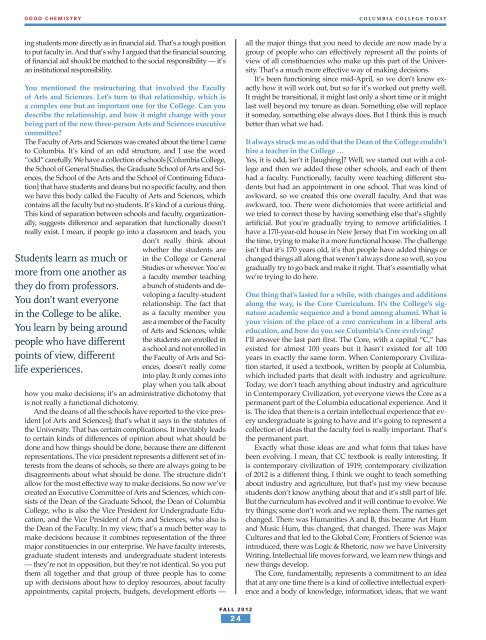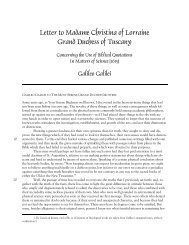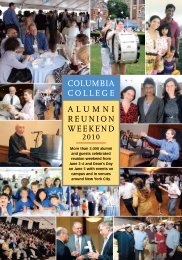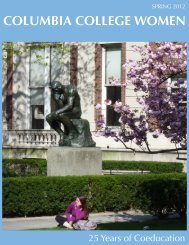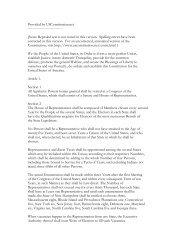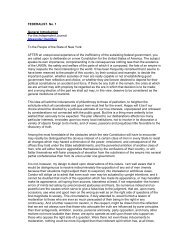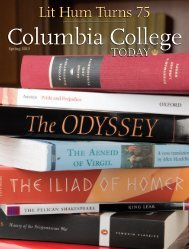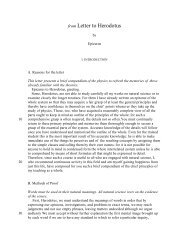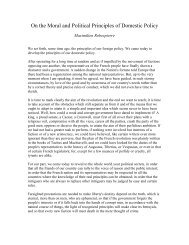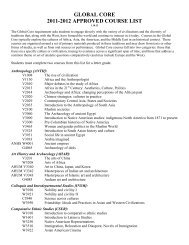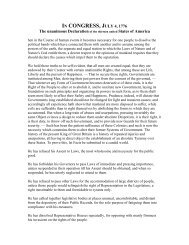Download this issue as a PDF - Columbia College - Columbia ...
Download this issue as a PDF - Columbia College - Columbia ...
Download this issue as a PDF - Columbia College - Columbia ...
Create successful ePaper yourself
Turn your PDF publications into a flip-book with our unique Google optimized e-Paper software.
GOOD CHEMISTRY<br />
COLUMBIA COLLEGE TODAY<br />
COLUMBIA COLLEGE TODAY<br />
GOOD CHEMISTRY<br />
ing students more directly <strong>as</strong> in financial aid. That’s a tough position<br />
to put faculty in. And that’s why I argued that the financial sourcing<br />
of financial aid should be matched to the social responsibility — it’s<br />
an institutional responsibility.<br />
You mentioned the restructuring that involved the Faculty<br />
of Arts and Sciences. Let’s turn to that relationship, which is<br />
a complex one but an important one for the <strong>College</strong>. Can you<br />
describe the relationship, and how it might change with your<br />
being part of the new three-person Arts and Sciences executive<br />
committee?<br />
The Faculty of Arts and Sciences w<strong>as</strong> created about the time I came<br />
to <strong>Columbia</strong>. It’s kind of an odd structure, and I use the word<br />
“odd” carefully. We have a collection of schools [<strong>Columbia</strong> <strong>College</strong>,<br />
the School of General Studies, the Graduate School of Arts and Sciences,<br />
the School of the Arts and the School of Continuing Education]<br />
that have students and deans but no specific faculty, and then<br />
we have <strong>this</strong> body called the Faculty of Arts and Sciences, which<br />
contains all the faculty but no students. It’s kind of a curious thing.<br />
This kind of separation between schools and faculty, organizationally,<br />
suggests difference and separation that functionally doesn’t<br />
really exist. I mean, if people go into a cl<strong>as</strong>sroom and teach, you<br />
don’t really think about<br />
whether the students are<br />
in the <strong>College</strong> or General<br />
Studies or wherever. You’re<br />
a faculty member teaching<br />
a bunch of students and developing<br />
a faculty-student<br />
relationship. The fact that<br />
<strong>as</strong> a faculty member you<br />
are a member of the Faculty<br />
of Arts and Sciences, while<br />
the students are enrolled in<br />
a school and not enrolled in<br />
the Faculty of Arts and Sciences,<br />
doesn’t really come<br />
into play. It only comes into<br />
play when you talk about<br />
how you make decisions; it’s an administrative dichotomy that<br />
is not really a functional dichotomy.<br />
And the deans of all the schools have reported to the vice president<br />
[of Arts and Sciences]; that’s what it says in the statutes of<br />
the University. That h<strong>as</strong> certain complications. It inevitably leads<br />
to certain kinds of differences of opinion about what should be<br />
done and how things should be done, because there are different<br />
representations. The vice president represents a different set of interests<br />
from the deans of schools, so there are always going to be<br />
disagreements about what should be done. The structure didn’t<br />
allow for the most effective way to make decisions. So now we’ve<br />
created an Executive Committee of Arts and Sciences, which consists<br />
of the Dean of the Graduate School, the Dean of <strong>Columbia</strong><br />
<strong>College</strong>, who is also the Vice President for Undergraduate Education,<br />
and the Vice President of Arts and Sciences, who also is<br />
the Dean of the Faculty. In my view, that’s a much better way to<br />
make decisions because it combines representation of the three<br />
major constituencies in our enterprise. We have faculty interests,<br />
graduate student interests and undergraduate student interests<br />
— they’re not in opposition, but they’re not identical. So you put<br />
them all together and that group of three people h<strong>as</strong> to come<br />
up with decisions about how to deploy resources, about faculty<br />
appointments, capital projects, budgets, development efforts —<br />
Students learn <strong>as</strong> much or<br />
more from one another <strong>as</strong><br />
they do from professors.<br />
You don’t want everyone<br />
in the <strong>College</strong> to be alike.<br />
You learn by being around<br />
people who have different<br />
points of view, different<br />
life experiences.<br />
all the major things that you need to decide are now made by a<br />
group of people who can effectively represent all the points of<br />
view of all constituencies who make up <strong>this</strong> part of the University.<br />
That’s a much more effective way of making decisions.<br />
It’s been functioning since mid-April, so we don’t know exactly<br />
how it will work out, but so far it’s worked out pretty well.<br />
It might be transitional, it might l<strong>as</strong>t only a short time or it might<br />
l<strong>as</strong>t well beyond my tenure <strong>as</strong> dean. Something else will replace<br />
it someday, something else always does. But I think <strong>this</strong> is much<br />
better than what we had.<br />
It always struck me <strong>as</strong> odd that the Dean of the <strong>College</strong> couldn’t<br />
hire a teacher in the <strong>College</strong> …<br />
Yes, it is odd, isn’t it [laughing]? Well, we started out with a college<br />
and then we added these other schools, and each of them<br />
had a faculty. Functionally, faculty were teaching different students<br />
but had an appointment in one school. That w<strong>as</strong> kind of<br />
awkward, so we created <strong>this</strong> one overall faculty. And that w<strong>as</strong><br />
awkward, too. There were dichotomies that were artificial and<br />
we tried to correct those by having something else that’s slightly<br />
artificial. But you’re gradually trying to remove artificialities. I<br />
have a 170-year-old house in New Jersey that I’m working on all<br />
the time, trying to make it a more functional house. The challenge<br />
isn’t that it’s 170 years old, it’s that people have added things or<br />
changed things all along that weren’t always done so well, so you<br />
gradually try to go back and make it right. That’s essentially what<br />
we’re trying to do here.<br />
One thing that’s l<strong>as</strong>ted for a while, with changes and additions<br />
along the way, is the Core Curriculum. It’s the <strong>College</strong>’s signature<br />
academic sequence and a bond among alumni. What is<br />
your vision of the place of a core curriculum in a liberal arts<br />
education, and how do you see <strong>Columbia</strong>’s Core evolving?<br />
I’ll answer the l<strong>as</strong>t part first. The Core, with a capital “C,” h<strong>as</strong><br />
existed for almost 100 years but it h<strong>as</strong>n’t existed for all 100<br />
years in exactly the same form. When Contemporary Civilization<br />
started, it used a textbook, written by people at <strong>Columbia</strong>,<br />
which included parts that dealt with industry and agriculture.<br />
Today, we don’t teach anything about industry and agriculture<br />
in Contemporary Civilization, yet everyone views the Core <strong>as</strong> a<br />
permanent part of the <strong>Columbia</strong> educational experience. And it<br />
is. The idea that there is a certain intellectual experience that every<br />
undergraduate is going to have and it’s going to represent a<br />
collection of ide<strong>as</strong> that the faculty feel is really important. That’s<br />
the permanent part.<br />
Exactly what those ide<strong>as</strong> are and what form that takes have<br />
been evolving. I mean, that CC textbook is really interesting. It<br />
is contemporary civilization of 1919; contemporary civilization<br />
of 2012 is a different thing. I think we ought to teach something<br />
about industry and agriculture, but that’s just my view because<br />
students don’t know anything about that and it’s still part of life.<br />
But the curriculum h<strong>as</strong> evolved and it will continue to evolve. We<br />
try things; some don’t work and we replace them. The names get<br />
changed. There w<strong>as</strong> Humanities A and B, <strong>this</strong> became Art Hum<br />
and Music Hum, <strong>this</strong> changed, that changed. There w<strong>as</strong> Major<br />
Cultures and that led to the Global Core, Frontiers of Science w<strong>as</strong><br />
introduced, there w<strong>as</strong> Logic & Rhetoric, now we have University<br />
Writing. Intellectual life moves forward, we learn new things and<br />
new things develop.<br />
The Core, fundamentally, represents a commitment to an idea<br />
that at any one time there is a kind of collective intellectual experience<br />
and a body of knowledge, information, ide<strong>as</strong>, that we want<br />
Professor at heart: Valentini chats with students outside Low Library <strong>this</strong> summer including (top, left to right) Annel Fernandez ’16, Xi<br />
Wang ’16 and Lorenzo Gibson ’16.<br />
PHOTOS: LESLIE JEAN-BART ’76, ’77J<br />
FALL 2012<br />
24<br />
FALL 2012<br />
25


